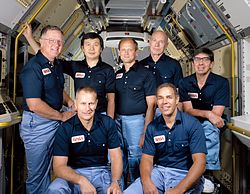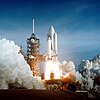STS-51-B
| Mission emblem | |||
|---|---|---|---|

|
|||
| Mission dates | |||
| Mission: | STS-51-B | ||
| COSPAR-ID : | 1985-034A | ||
| Crew: | 7th | ||
| Begin: | April 29, 1985, 4:02:18 pm UTC | ||
| Starting place: | Kennedy Space Center , LC-39A | ||
| Landing: | May 6, 1985, 4:11:04 p.m. UTC | ||
| Landing place: | Edwards Air Force Base , Runway 17 | ||
| Flight duration: | 7d 0h 8m 46s | ||
| Earth orbits: | 111 | ||
| Track height: | 411 km | ||
| Orbit inclination : | 57.0 ° | ||
| Covered track: | 4.6 million km | ||
| Payload: | Spacelab | ||
| Team photo | |||
 v. l. No. front: Robert Overmyer, Frederick Gregory, back: Don Lind, Taylor Wang, Norman Thagard, William Thornton, Lodewijk van den Berg |
|||
| ◄ Before / After ► | |||
|
|||
STS-51-B ( English S pace T ransportation S ystem ) is a mission designation for the US Space Shuttle Challenger ( OV -99) of NASA . The launch took place on April 29, 1985. It was the 17th space shuttle mission and the seventh flight of the space shuttle Challenger.
team
Main team
- Robert Overmyer (2nd space flight), commander
- Frederick Gregory (1st spaceflight), pilot
- Don Lind (1st space flight), mission specialist
- Norman Thagard (2nd spaceflight), mission specialist
- William Thornton (2nd spaceflight), mission specialist
- Lodewijk van den Berg (1st spaceflight), Payload Specialist, EG&G Corporation
- Taylor Wang (1st Spaceflight), Payload Specialist, California Institute of Technology
replacement
- Eugene Trinh and Mary Helen Johnston for Wang and van den Berg
Mission overview
STS-51-B took off just 17 days after the start of the previous shuttle mission STS-51-D . Due to a technical problem in the automatic start sequence, the STS-51-B mission started with a delay of two minutes and 18 seconds.
The mission's payload consisted of the Spacelab of the European Space Agency (ESA). 15 experiments were carried out, mainly to investigate liquids and materials in weightless space. Two monkeys and 24 rodents were also on board for biological studies. 14 experiments were successfully carried out.
Another payload was the GLOMR military satellite . Due to a battery problem, it was not abandoned and taken back to earth for a later launch.
The landing took place at Edwards AFB in California; for the first time a shuttle landed in a crosswind. Challenger was transported back to Cape Canaveral , Florida five days later by special aircraft.
See also
Web links
- NASA Mission overview (English)
- Video summary with comments of the crew (English)
- STS-51-B in the Encyclopedia Astronautica (English)
